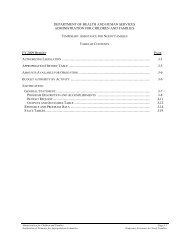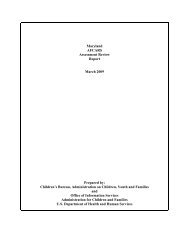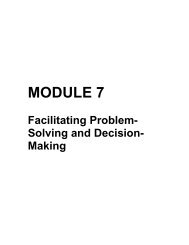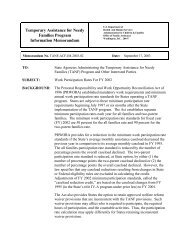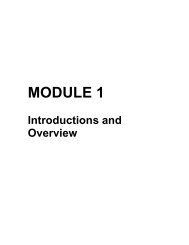Delivering Training and Technical Assistance - Administration for ...
Delivering Training and Technical Assistance - Administration for ...
Delivering Training and Technical Assistance - Administration for ...
Create successful ePaper yourself
Turn your PDF publications into a flip-book with our unique Google optimized e-Paper software.
APPENDIX DLearning StylesWhen you deliver in<strong>for</strong>mation in a training session, you will soon notice that learners have differentpreferences <strong>for</strong> receiving in<strong>for</strong>mation. The three learning modes are:1. Visual2. Auditory3. KinestheticAll learners can learn through each of these modes, but they usually have a strong preference <strong>for</strong> one. As atrainer, you need to use a variety of methods to reach all three types of learners.1. Visual Learners:a. Prefer to learn through reading <strong>and</strong> seeingb. Like to read h<strong>and</strong>outs <strong>and</strong> look at charts <strong>and</strong> graphsc. Are often bored by lectured. Develop interest when PowerPoints are usedTo create a positive environment <strong>for</strong> visual learners, provide diagrams <strong>and</strong> explain them. Ask participants todraw a picture. Include plenty of content in your h<strong>and</strong>outs, including extra material to read after the session.Write key words on a flip chart or white board.2. Auditory Learners:a. Prefer to learn by listeningb. Can learn from lectures with or without taking notesc. May benefit from recording <strong>and</strong> reviewing a content-heavy presentationd. May have difficulty absorbing written materiale. Like break-out groups to discuss content <strong>and</strong> hear the perspectives of othersTo create a positive environment <strong>for</strong> auditory learners, use lecture, question <strong>and</strong> answer, <strong>and</strong> discussions.Break into small groups often. Play a song to illustrate a point or use background music when appropriate.Allow time at the end of a training to summarize your main points <strong>and</strong> allow <strong>for</strong> additional questions.3. Kinesthetic Learners:a. Prefer to learn by touching <strong>and</strong> doingb. Can become quickly bored if they do not stay activec. Find that taking notes help them concentrate on a presentationd. Often use a highlighter to help when they are readingTo create a positive environment <strong>for</strong> kinesthetic learners, use creative activities that get people out of theirchairs <strong>and</strong> doing something interesting. Put Play-Doh, pipe cleaners, or other objects at their tables so theycan do something with their h<strong>and</strong>s. Take frequent stretch breaks, even if you don’t leave the room.Appendix D | 35



